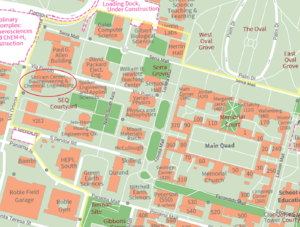Difference between revisions of "Biology Team"
| Line 27: | Line 27: | ||
Once you're part of SSI's Slack team, we encourage you to join biology-related channels. #biology and #biology-reading are great places to start. #biology-terminator and #biology-backspace are where we work on [[Enzymatic Synthesis Methods]], and #biology-device is for developing our [[Electrowetting on Dielectric]] system. | Once you're part of SSI's Slack team, we encourage you to join biology-related channels. #biology and #biology-reading are great places to start. #biology-terminator and #biology-backspace are where we work on [[Enzymatic Synthesis Methods]], and #biology-device is for developing our [[Electrowetting on Dielectric]] system. | ||
| + | |||
| + | [https://mailman.stanford.edu/mailman/listinfo/ssi_biology Mailing List] | ||
| + | |||
| + | Most of our communication is done through Slack, but we also have a mailing list for important announcements and events. | ||
[https://drive.google.com/drive/u/1/folders/0B8-62fA-f9yzeC05NTByMVpoTVU Google Drive] | [https://drive.google.com/drive/u/1/folders/0B8-62fA-f9yzeC05NTByMVpoTVU Google Drive] | ||
Revision as of 03:38, 4 October 2017
The Biology team is SSI's fourth project team, focusing on the intersection between the life sciences and space. The Biology team began work on its pilot project, building a portable, autonomous DNA Synthesizer to send to space, in the 2016-2017 academic year. The Biology team works in the Shriram Center for Bioengineering and Chemical Engineering, using the Uytengsu Teaching Lab space. It is currently developing enzymatic DNA synthesis methods and an electrowetting fluid handling platform for this project, which they aim to launch as a cubesat payload or operate on the International Space Station. The Biology team is also open to other project ideas, particularly relating to astronaut life support, biomaterials for space use, and terraforming for space colonization.
The Biology team's faculty advisor is Prof. Drew Endy, and current team co-leads are Alan Tomusiak and Cynthia Hao.
Joining SSI Bio
1) Visit the How to join SSI page and complete the four steps to joining SSI. Congratulations! You're now an SSI member. Continue on for biology.
2) Complete the EHS-1500 AXESS safety training. Upload documentation onto internal.stanfordssi.org, under 'Trainings.' A screenshot is fine as documentation. In case you run into problems at this step, simply e-mail the co-leads proof of completion.
3) Complete the Lab Safety Form.
4) Join the ![]() #biology
#biology ![]() #biology-terminator
#biology-terminator ![]() #biology-backspace
#biology-backspace ![]() #biology-device
#biology-device ![]() #biology-reading
#biology-reading
5) Fill out this brief interest form.
Congratulations! That's it!
Our Projects
We're currently building a DNA Synthesizer to make DNA in space. Come join us! Our 2017-2018 team is subdivided into three groups--one working on DNA synthesis with chemical blocking groups, one that will use exonuclease, and one designing an Electrowetting on Dielectric fluid handling platform. See a list of ongoing subprojects and tasks here.
Resources
Once you're part of SSI's Slack team, we encourage you to join biology-related channels. #biology and #biology-reading are great places to start. #biology-terminator and #biology-backspace are where we work on Enzymatic Synthesis Methods, and #biology-device is for developing our Electrowetting on Dielectric system.
Most of our communication is done through Slack, but we also have a mailing list for important announcements and events.
Check out the Biology team folder in the SSI Google Drive for useful documents, including the Biology inventory, readings spreadsheet, and solution calculator.
We use Overleaf to write up protocols and analysis for our experiments. Our generic protocol template is on Slack, as well as some examples of previous experiments we've run.
SSI Biology uses a Mendeley community to keep track of relevant papers and protocols.
